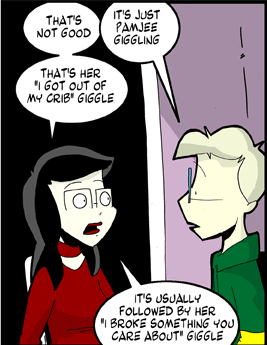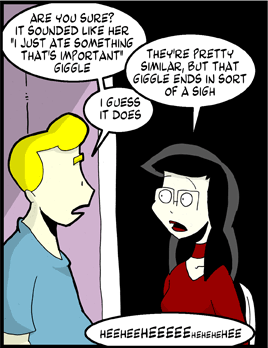Baby talk
« previous post | next post »
 Many parents are oblivious to the nuances of their children's paralinguistic vocalizations. But not Aubrey Chorde, from the most recent Something Positive, who is interpreting here for her friend and house-guest Davan MacIntyre.
Many parents are oblivious to the nuances of their children's paralinguistic vocalizations. But not Aubrey Chorde, from the most recent Something Positive, who is interpreting here for her friend and house-guest Davan MacIntyre.
Some pre-verbal sound-meaning correspondences are universal — crying and laughing, for example. Some more subtle differences, like empty-stomach crying and full-diaper crying, are (I think) interpretable to some extent across children. But just like adults, very young children also develop idiosyncratic cries, laughs, grunts, giggles, and so on. And their lack of self-censorship makes these especially useful sources of information about their internal lives (and external but out-of-sight activities).
Pamjee's father Jason has a different interpretation, but Aubrey's exegesis persuades him to her point of view:

As you'll find out when you read the whole strip, Aubrey is apparently correct, but the point is moot.
Twitter Trackbacks for Language Log » Baby talk [upenn.edu] on Topsy.com said,
December 21, 2010 @ 9:47 am
[…] Language Log » Baby talk languagelog.ldc.upenn.edu/nll/?p=2852 – view page – cached December 21, 2010 @ 8:57 am · Filed by Mark Liberman under Linguistics in the comics […]
Dan T. said,
December 21, 2010 @ 10:08 am
The old comic book series Sugar and Spike featured babies who were fluent in "baby talk" that was understandable to one another but incomprehensible to adults.
Jim said,
December 21, 2010 @ 4:02 pm
This is, I think, part of the reason why communication breaks down a bit when children learn to self-censor – even for my eight year old, I can tell from the cadence of his speech and other verbal queues when he's telling the truth as well as his general emotional state with great accuracy. And, in defiance of societal norms, I'm generally better at this than my wife is.
Jeremy said,
December 21, 2010 @ 10:03 pm
My friend's daughter is almost one. She's evidently got quite a repertoire of cries, noises and gestures, but I can't make heads or tails of any of it. Mom, on the other hand, knows them quite well.
As this is a language blog, does anyone know anything about "baby sign"? Now that my acquaintances are having children, this comes up now and again, but it sounds almost too good to be true.
Lucy Kemnitzer said,
December 22, 2010 @ 11:04 am
I'm pretty good at "reading" babies — it's been my job for a long time, after all. But I don't think it's because there's a very fine-grained universal baby language. I think the universal baby language is confined to the early months, and consists of levels of discomfort, signs that all is well and should continue like this, and most specifically important to language development, signals to inspire and maintain social interaction.
Almost immediately babies begin the task of making language out of their interactions with their caregivers, and that necessarily immediately introduces a lot of room for idiosyncrasy (which is how you get jokes about parents discussing "her sound for — "). The babies I've cared for over the years all had utterly individual expression styles within weeks.
—–
About baby signing:
I don't know what claims you're hearing for them, but this much is true: baby signs are easier to produce than speech. They are broad gestures which can be made with the whole hand and arm. So babies who are on the threshold of producing speech can "say" more things with baby signs than with spoken words. It's really satisfying for parents and children. It's fun in the same way that fingerplay is and also allows kids to ask for more precise things and to make a few more comments than they could otherwise do in that period of their life.
As far as I know, it has no significant lasting effects on language acquisition. But it doesn't need to. It's fun while it lasts, and moderately useful.
Jeremy said,
December 22, 2010 @ 7:40 pm
Lucy: thanks for the info. I haven't heard anything about benefits beyond the here-and-now practical communication. Maybe I was taking the communication benefits to mean more than they were meant to. It still sounds useful and fun, so might try it out with mine if I ever get around to having them.
Ben Hemmens said,
December 26, 2010 @ 2:37 pm
It's certainly been a very educational experience (for me) to see how richly a baby can communicate with her parents (my daughter is now a little over 9 months old). I'm too tired to attempt a list of her distinct noises, but it would be long, and irrelevant for anyone else.
I'm flattered by the way that "da-da-da" is part of her happy babbling whereas "maaa" and sometimes "maaa-maa" are a complaining signal ;-) – but there's no sign of her having names for either of us yet. It remains to be seen what she will end up calling me, as I think of myself as her da or dad, but the rest of the family (German-speaking) thinks I'm her papa.
I can't resist an off-topic comment: I find it particularly fascinating that she likes having quite complicated books read to her, e.g. The Snail and the Whale, so it seems like a sense of a good story comes well before being able to understand the content of any story.
Ray Dillinger said,
December 26, 2010 @ 6:31 pm
What I thought of when I read this comic was animal signaling. With our cats, I can easily tell the difference between "hungry" meows and "cold" meows and "Let me in/out" meows and "lonely" meows and several other varieties. There's also the "nervous" purr and the "content" purr and the "reassurance" purr (the latter apparently produced to declare nonaggression or put other cats at ease).
I guess we don't call it "paralinguistic" when it comes from creatures not otherwise able to use language, but there's a definite encoding of messages of sorts going on with socialized animals, and it seems not too dissimilar from what babies seem to have when they start acquiring language.